Growing Hibiscus plants in your home can give you abundant flowers and a tropical feeling. There are mainly three varieties, native, tropical, and hardy, and pruning can benefit all the varieties.
To correctly prune a hibiscus plant, first, you need to find a node and trim the branch 1/4th inch above the node. Don’t prune more than 1/3rd or 1/4th of the plant, but trim the dead, damaged parts and leggy limbs. Pruning the plant encourages new growth in the hibiscus plant.
There are many things to understand about pruning the Hibiscus plants, including variety, the right time, and methods. So, keep reading if you want to learn the correct way to prune Hibiscus for bushy growth.
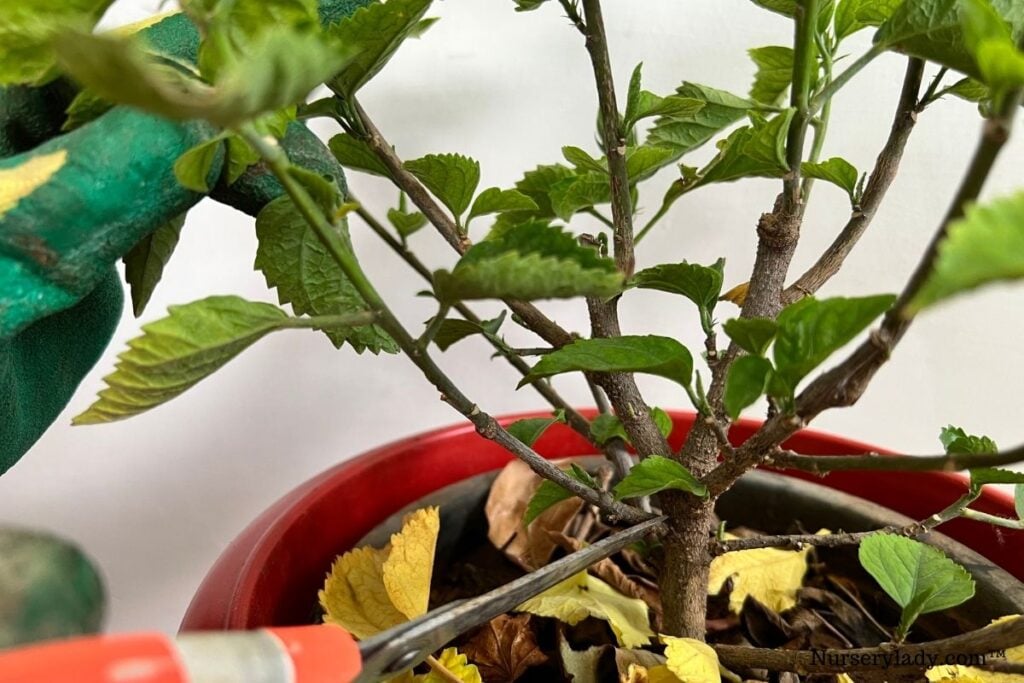
When to prune Hibiscus plants?
There are mainly two types of Hibiscus plants – Tropical and Hardy.
The best time to prune Tropical Hibiscus is when the weather becomes warm.
In most areas, it is the spring season.
The best time to prune Hardy Hibiscus is early spring and late winter.
Pruning during extreme heat is stressful.
The best time to prune is when the weather is sunny and mild.
For pruning Hibiscus at the right time, below are some guidelines to follow:
- If you live in warm climates where the winters are not freezing, prune during the late fall.
- It will give energy to the roots first, and when spring arrives, the branches will grow along with beautiful flowers.
- If you live in colder climates having high chances of frost, prune the grounded Hibiscus in the spring and avoid fall pruning.
- If your potted plant is inside and you have kept them near a sunny window, prune during the fall. If they receive full sun adequately, they will regrow the branches and flower when you keep them outside in spring.
- If your potted Hibiscus is in a dark place, wait until the early spring to prune. If you have a short summer, consider selective pruning. Before storing, consider light pruning.
- For hard pruning, the best time is spring. This kind of pruning is stressful. Conducting this on warm sunny days will encourage the plant to grow new branches.
- If you have a sunny greenhouse in winters, consider hard pruning in January. Pruning should be done when the surrounding has cooled down. It is because the circumstances are scorching during the day. As I mentioned before, pruning during heat moments can stress the plant.
- If you live in a region that receives little chance of freezing and your plant is on the ground, you don’t have to prune. Hibiscus won’t require any special care except light, water, and fertilizer.
Why should I prune Hibiscus plants?
Hibiscus is grown for its beautiful vibrant flowers.
Pruning the extra branches can promote new branch growth from where more flowers will emerge.
The more branches the plant will grow, the more flowers you will see in the plant.
Besides, it keeps the plant tidy and in shape, thus increasing its visual interest.
So, if you don’t prune the Hibiscus plants, you won’t be able to find more flowers in the plant.
You don’t need to prune the branches.
Select some of them and prune as required.
However, some plants don’t require pruning, which I mentioned earlier.
Some plants grow seamlessly.
Without pruning, they can grow bigger and bushier over time.
The plant only needs light, water, and fertilizer.
This situation is rare.
Types of pruning
There are many types of pruning, and each type is performed either at separate times or with different varieties.
There are five types of pruning:
- Selective pruning
- Corrective pruning
- Pinching
- Full pruning
- Hard pruning
Let’s understand how to perform these pruning techniques.
How to prune selectively?
In this method, only some selective branches are trimmed.
Only 1/3rd of the plant will be pruned and not more than that.
It is a beneficial one.
It helps in encouraging new branches and more flowers without disturbing the other branches that are still blooming.
But to do this in the right way, you need to select the right branches.
Remove the downward-facing and inward-facing branches.
Flowers emerge from the tip of the branches.
If the branches of their nodes face inwards or downwards, the flower will not grow straight.
That is why you should prune them.
If the branches are in the upward direction, don’t prune them. Instead, you can shorten them.
How to do corrective pruning?
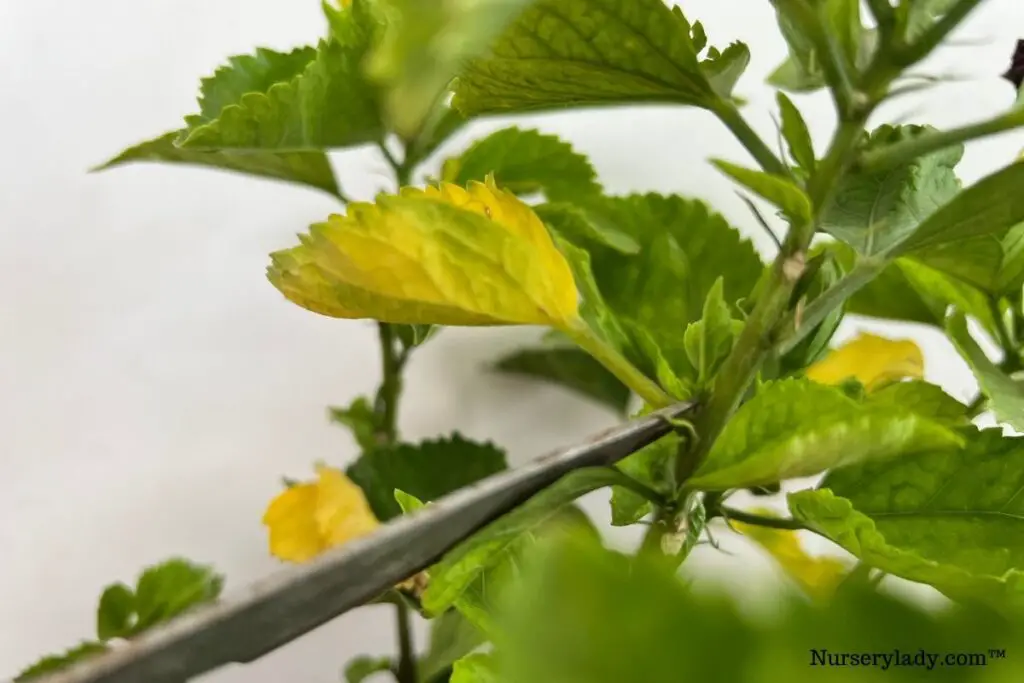
It goes side by side with selective pruning.
Corrective pruning means pruning the distorted and damaged branches to correct the look of the plant.
If you think some branches are good but could have been better, you can prune them to improve their growth and encourage healthy regrowth.
Look for the dead, diseased, wilted, sick, lop-sided, or rotted branches.
Any branch that doesn’t look suitable with the look of your Hibiscus plant should be removed from the plant.
Pinching
This is a minor pruning technique and can be done throughout the season.
It doesn’t require any specific time or season.
Though Hibiscus can self-clean them by falling off the spent flowers on their own, you can still pinch them off.
Pinch them 1/4th inch below the flower’s head.
You can also pinch the branch’s tips around a few inches for more growth and flowering.
Looking for gardening supplies? We have tested 100's of products before recommending them to you guys. Check out our best pick below:
| Image | Gardening Supplies | Best Price? |
|---|---|---|
 Top
Top Top
Top | Raised Garden Bed Kit | Check On Amazon |
 | XLUX Soil Moisture Meter, Plant Water Monitor, Soil Hygrometer Sensor for Gardening, Farming, Indoor and Outdoor Plants, No Batteries Required | No Results |
 Top
Top Top
Top | 82 Pcs Garden Tools Set and Extra Succulent Tools Set | Check On Amazon |
 | Joeys Garden Expandable Garden Hose with 8 Function Hose Nozzle, Lightweight Anti-Kink Flexible Garden Hoses, Extra Strength Fabric with Double Latex Core, (50 FT, Black) | No Results |
 Top
Top Top
Top | Dual Chamber Compost Tumbler | Check On Amazon |
 Top
Top Top
Top | Sunnyglade Plant Stakes | Check On Amazon |
 Top
Top Top
Top | Organic Cold Pressed Neem Seed Oil | Check On Amazon |
 Top
Top Top
Top | Mighty Mint Gallon :-Insect and Pest Control Peppermint Oil | Check On Amazon |
 Top
Top Top
Top | Scotts DiseaseEx Lawn Fungicide | Check On Amazon |
 Top
Top Top
Top | Jacks Classic 20-20-20 All Purpose Fertilizer | Check On Amazon |
 Top
Top Top
Top | 30,000 Seeds Pollinator Attracting Wildflower Mixture | Check On Amazon |
 Top
Top Top
Top | Survival Vegetable Seeds Garden Kit-Over 16,000 Seeds | Check On Amazon |
How to do full pruning?
Hibiscus branches are trimmed below 2-3 nodes per branch in this type of pruning.
After pruning, you have to wait for some time to see the new branch and flower growth.
This type of pruning gives your plant the best amount of flowers and makes the plant look well-balanced and good to look at.
This is the usual type of pruning done for all Hibiscus plants.
It is generally done early in the growing season to encourage prolific and abundant blooming in the coming spring and summer.
How to perform hard pruning?
This is only done during drastic situations with only mature and old plants when they have skinny growth and lots of dead woods.
Keep the plant one foot above the soil and trim the other branches.
Get rid of the large branches. Each branch should have at least 3-4 nodes.
This is for the mature plants that don’t bloom well.
It is good for the old, tall plants will have a lot of branches or branches with few or no leaves.
Hard pruning encourages the plant to grow new branches and compact, bushy plants filled with leaves and flowers.
How to prune Hibiscus plants? – Step-by-step guide
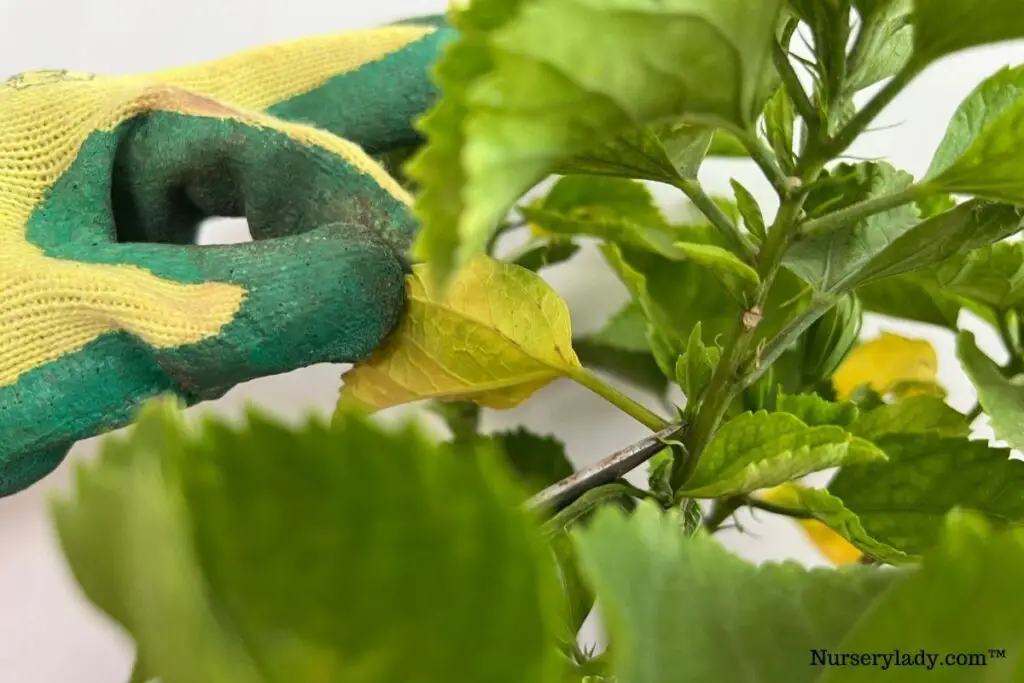
Now, let’s begin with the steps to pruning Hibiscus plants:
Tools needed
A few things are needed for pruning – gloves and a sharp pruner.
Make sure that the pruner is clean. Spray some rubbing alcohol or any other sanitizer to disinfect the pruner.
This will ensure a clear cut and prevent disease transmission.
A step-by-step guide to pruning
1. Disinfect the tools
First, clean and disinfect the pruner with alcohol-based gel, rubbing alcohol, bleach water, or any other products available for disinfecting.
Let the products remain in the tools for some time.
Some products need time to start working and kill viruses, bacteria, or fungi.
2. Watch the plant carefully and plan the place for pruning.
Have a good look at the plant, its branches, the height and thickness of the branches, the directions they are pointing, etc.
Also, have a look at the place where you want to cut.
The new growth will appear from below the cut area.
Cutting only a few inches off the top will not appear attractive because new growth growing from the end of an existing branch doesn’t look good.
3. Select the right node before cutting
Find the right node.
A node is a place from where a leaf emerges.
Even if the leaf falls, the node will be there.
While pruning, you have to cut above the node. The flower buds will grow from the branch tips.
4. Finally, prune the branches.
Select a long branch at first for cutting.
Trim the branch at 1/4th inch above the node.
There must be 1/4th inch of space between the node and the cut portion.
Move to the next branch and repeat the same method.
Cut around 1/3rd or 1/4th of the plant.
Leave 2-3 nodes from the branch’s top for full pruning and cut above the next leaf node.
For hard pruning, cut the branch and leave 2-3 nodes in each branch.
The only consideration is that you should do it with the mature trees.
Never prune more than 30-50%.
Otherwise, that will weaken the plant.
5. Consider other pruning along with the main pruning.
Trim off the dead, diseased, and damaged leaves.
This is corrective pruning.
To control the direction of the new growth, consider selective pruning.
If you find a node that will not grow the flower in the direction you want, cut the branch below that node.
Find a node growing in the direction you want, and cut the branch above that node.
For proper new growths, make sure that there should be ¼ inch gap between the node and the place of cutting.
The pruning steps are the same for both the Hibiscus varieties.
How to prune an old Hibiscus plant?
Sometimes, you will find that the plant is not having any new growth at the bottom of the plant.
This kind of plant is an aged plant.
It means that they won’t have new growth now without any provocation.
So, when you want this type of plant to have new growth, hard pruning will help.
Cutting the upper portion of the plant to shorten it down might seem strange, but it changes the flow of hormones and encourages new branch growth.
Cut the branches by leaving 3-4 nodes from the top.
Repeat this with all the other branches.
Ensure that the plant has a branch at least one foot above the ground.
There must be some healthy green leaves in the plant for the functioning of photosynthesis.
Do this every 3-5 years.
How to prune a standard Hibiscus tree?
Many people from the tropical regions grow Hibiscus as a tree in their garden and other plants like roses and citrus.
It looks better than those in the pots.
They don’t require any heavy pruning because they look neat due to one long main branch having multiple other branches, leaves, and flowers in good shape at the top.
However, you can still prune to maintain a round and clear shape.
When the top branches grow, prune the tips of the new growth and leave behind 2-3 nodes in it.
Repeat the same for all.
Prune the overlong, lower-side, and uneven branches to maintain a crown-shaped plant.
Continuing this will maintain the right shape of the tree.
How to prune a damaged Hibiscus plant?
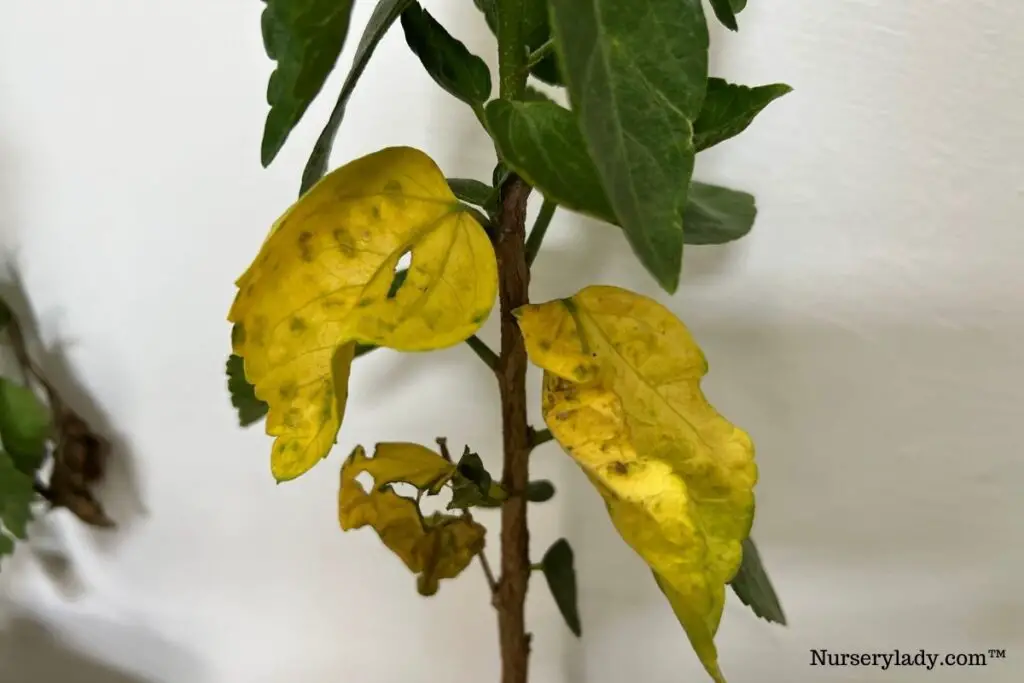
If you live in a cold region and grow Hibiscus outside, the plant will face frost damage.
In this situation, your Hibiscus will require pruning.
But it is quite different from the usual pruning.
It might be tempting to prune the damaged parts during the winter, but you shouldn’t do that.
Wait until the risk of frost is over.
Only then should you approach pruning the damaged parts.
Along with the frost-damaged parts, you also have to prune off the diseases, rotten and dead parts.
First, check for the live wood in the plant.
Scratch the branches from the tip to the end.
The live branches will be green inside, and the dead branches will be light tanned.
Some of these dead branches will also be rotten and soft.
You don’t have to test them because they have already started rotting.
The green color mixed with some brown will also require pruning because they won’t live for long.
Check from where the live wood started and find the highest spot of the live wood.
Now find the next node from the highest spot of the live wood.
Cut the branch 1/4th inch above that node.
When you cut the branch, make sure that the inner branch is clean and white.
If it isn’t white, cut the branch some more inches.
Make sure that the cut part should be always above a leaf node.
How to prune a mature and neglected plant?
If you have a mature Hibiscus that got neglected, the plant will have lots of dead woods and leggy, uncontrolled growth.
Here, you have to consider hard pruning.
Cut the branches as much as you can, leaving a couple of nodes in each stalk.
The plant will take some time to have new growth, but you will love the look when it does.
Pruning differences between Tropical and Hardy Hibiscus
The main difference in pruning between the Tropical Hibiscus and Hardy Hibiscus lies in the inches of branches you cut and the timing.
In the Tropical Hibiscus plant, you have to prune at least 12 inches of the mature branches for good regrowth.
On the contrary, you have to prune only 3 to 6 inches of the branch in the Hardy Hibiscus plants.
Tropical Hibiscus is pruned heavily in the early spring to encourage vigorous growth and flowering in the spring and summer.
Besides, you can also prune slightly (not heavy pruning) during the growing season by pinching the branch’s top.
Hardy Hibiscus is pruned in the early spring and late winter.
You can also trim them after the first bloom by slightly pinching the top branches to encourage flower growth.
Trim Hardy Hibiscus slightly around 4-5 inches after the first hard frost to keep them tidy.
Pruning aftercare
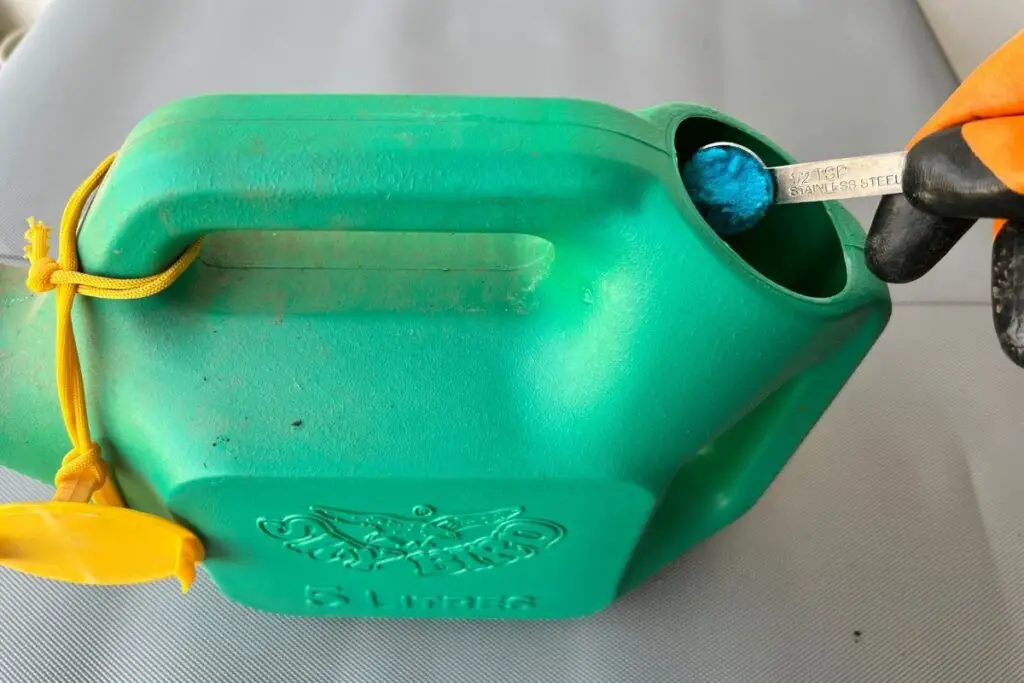
After pruning, take care of the plant to stimulate further growth.
It will take a lot of time to grow new branches, leaves, and flowers.
After pruning in spring, fertilize the Hibiscus with a potassium-rich flowering plant food.
Look for fertilizers having an NPK ratio of 6-4-6 or 3-1-2.
Make sure that the fertilizer doesn’t have high nitrogen or phosphorus.
Apply the dose to half the recommended amount.
Mix 1 or ½ teaspoon of fertilizer with 1-gallon water and apply it every week with watering.
For using a slow-release, apply every 3-4 months with some regular feeding with a high potassium-based fertilizer (1-2 times per month) in the growing months.
Keep the Hibiscus plants evenly moist.
If you find bugs or insects, remove them quickly to prevent the new approaching shoots from infestation.
Final words
Pruning hibiscus may sound difficult if you are a beginner. But, you can excel in it with regular practice. The main pruning is full pruning done in all Hibiscus varieties during the early season.
Tropical Hibiscus is generally pruned only in the early spring. You can prune the Hardy Hibiscus in the early spring. Another time is the late winter. It prepares the plant for the spring.
Besides, you can also consider the other types of pruning to maintain the flowering direction and keep the plant clean and free from dead and damaged branches. Hard pruning should only be done with the old mature plants.
After pruning, take care of the plant and stimulate their growth by fertilizing them and keeping the soil moist.
Reference: Wikipedia, ASPCA, Louisiana State University Agricultural Center, American Society for Horticultural Science, Tropical Hibiscus by Texas A&M University, Sciencedirect.
